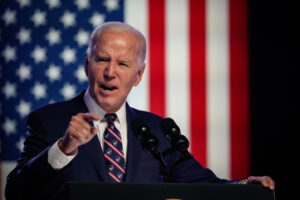In early 2018, I attended a reading at an independent bookstore in the heart of bourgeois Brooklyn. It was to launch the memoir of a Mexican-American former Border Patrol agent who had become disillusioned and quit. To the surprise of most of those present, a group of aggressive protesters also showed up, dead set on preventing it from happening. Their objection was to the author’s prior employment in a law enforcement agency that had become central to Donald Trump’s immigration crackdown.
It didn’t matter that the book was critical of the Border Patrol; as the protesters saw it, to treat that agency’s operations with literary nuance and moral complexity was as obscene as doing so with the Gestapo. They tried to shame attendees into leaving, then repeatedly shouted down the author, derailing the discussion until the store manager called the police. After loudly denouncing her, they left.
I don’t know whether any of these hecklers called themselves “Antifa”, but their disruption of a minor literary event was just one small indication of the extent to which the movement’s values and tactics went mainstream during the Trump era. For decades, Antifa activists had focused their attention on shutting down the activities of fringe far-Right groups with violence if necessary. But with Trump in the White House, many concluded the domain of the struggle needed to be extended. In their panicked state post-2016, many liberals and mainstream progressives who might have once eschewed Antifa’s rejection of free speech and advocacy of violence against ideological opponents came to regard them as a last line of defence against a surging Right.
In reaction, Antifa became a central element of conservative demonology in the Trump era, especially during the riots set off by George Floyd’s killing in 2020, in which masked “black bloc” agitators were often seen setting fires and causing mayhem. As Minneapolis burned, Trump claimed on Twitter that his administration would designate Antifa a terrorist organisation. This never happened — and since the United States lacks a domestic terrorism law, it is unlikely it will in the event of a second Trump term.
At the local level, however, conservatives are now testing out other ways of cracking down on the movement. This month, the District Attorney of San Diego, California, brought conspiracy charges against two Antifa activists who were involved in street brawls in early 2021, in effect trying to prosecute them using a legal toolkit created to fight organised crime.
Both the prosecution and the defence in the Antifa trial lay claim to free speech. In her opening statement, the Deputy District Attorney alleged that the defendants conspired “to shut down the speech and the assembly of a patriot group” (they were protesting a pro-Trump rally of the Proud Boys and other far-Right groups). In response, as well as arguing the prosecution is politically motivated — plausibly, given that the government opted not to prosecute any of the Right-wingers involved in the street fights in question — defence attorneys contend that the conspiracy charge threatens free political expression, because it will have a “chilling effect” on anyone protesting Right-wing gatherings.
The irony of the defence attorneys’ argument is that Antifa advocates are often explicit about doing what prosecutors allege — conspiring, or at least coordinating, to prevent those it defines as “fascist” from speaking and assembling. They are also open about the fact that they reject the liberal conception of free speech. In Antifa: The Anti-Fascist Handbook, the historian and activist Mark Bray writes: “At the heart of the anti-fascist outlook is a rejection of the classical liberal phrase incorrectly ascribed to Voltaire that ‘I disapprove of what you say, but I will defend to the death your right to say it’.” Bray, whose book is at once a history of Antifa, an apologia for its approach, and a how-to guide for aspiring militants, writes that the movement is “committed… to fighting to the death the ability of organized Nazis to say anything”. (“To the death” here is literal: Bray approvingly cites historical instances of murders committed by anti-fascists.)
Like many Antifa sympathisers, Bray directs much of his ire at liberal free-speech advocates, whom he believes are naïve devotees of the “marketplace of ideas”. The reality, though, is that after Trump’s election, many liberals and liberal institutions embraced Bray’s position. Indeed, the popularity of his book — which garnered many positive reviews in the mainstream press and scored Bray multiple NPR interviews — was an indication of this shift. The most dramatic about-face occurred at the ACLU, long notorious for defending the right of a Nazi group to hold a rally in Skokie, Illinois, in 1977. The organisation took the same consistent free-speech stance prior to the 2017 Charlottesville “Unite the Right” rally, but after the deadly events of that day, it began to waver, with many of its employees publicly disavowing its prior position.
In another sign of the patina of respectability Antifa acquired in the Trump era, in early 2018 Minnesota congressman Keith Ellison — then the deputy chair of the Democratic National Committee — promoted Bray’s book on Twitter, saying it would “strike fear in the heart of [Donald Trump]”. This was quite a reputational upgrade for a movement that, as Bray’s historical account details, existed for many decades mainly as a minor skinhead subculture devoted mainly to brawling with equally marginal groups of neo-Nazi skinheads.
For much of its existence, however, Antifa had a more ambivalent relationship with the liberal mainstream than its frequent denunciations of liberal proceduralism would imply. The movement first emerged alongside and in response to the rise of fascism in interwar Europe; the first anti-fascist militants were communists, socialists and anarchists who took to the streets to confront fascist paramilitary groups such as the SA in Germany and the Blackshirts in Italy. At this time, their violent struggle was part of a broader revolutionary agenda. Defeating fascists, viewed as the shock troops of capital, was one piece of the larger radical social transformation they sought, often inspired by the recent Bolshevik triumph in Russia (the fascists, for their part, saw their violent activities as justified by the threat of Bolshevism). Yet in nearly every country, they failed not only to bring about a communist revolution but to block the rise of the far-Right.
It was only in the post-war era, with the West settled under liberal-democratic rule, that Antifa re-emerged in something like its current form. With the dream of universal communist revolution deferred, the movement focused largely on beating back the scattered far-Right groups that persisted. While still deploying the rhetoric of the revolutionary Left, these militants were for the most part resigned to policing the outer fringes of acceptable discourse, following terms set by the liberal mainstream they despised. To the extent their use of political violence was tolerated, it was in large part because their far-Right targets had already been pushed to the margins of society by other means, or because they unfolded in subcultural spaces of little broad political significance.
In making the case for the efficacy of Antifa tactics, Bray and other apologists often point to concrete successes at preventing some particular neo-Nazi group from gathering or speaker from speaking. But it was the subtler, more comprehensive methods of enforcing ideological consensus employed by the liberal mainstream that rendered these fringe groups vulnerable to the antics of a handful of activists in the first place. Conversely, Antifa has had less success lately at shutting down Right-populist leaders and parties it dubs fascist, from Trump to Marine Le Pen and Giorgia Meloni — for the simple reason that it is unable to muster sufficient numbers to physically confront their mass base of support. Even Bray concedes the movement’s tactics are inadequate to take on this new enemy.
Hence, Antifa faces the problem that its approach is more likely to rack up successes when the stakes are lowest; when those it dubs “fascist” manage to command a broad base of support, it seems unable to scale up its approach. An approach calibrated to shutting down a bar show by a neo-Nazi hardcore band is unlikely to have much effect on a Trump rally. The liberal establishment, it would seem, began to embrace Antifa just as its tactics were becoming irrelevant.
And yet, the possibility of effective collaboration between the centre-left and Antifa activists was on view this week, in the briefly successful attempt to shut down the National Conservatism conference in Brussels. Belgian anti-fascists had repeatedly demanded the conference be prevented from happening, and the local mayor used the pretext of potential violence from counter-protesters to justify asking the police to break up the gathering on public safety grounds. Ultimately, a court forced the city government to allow the conference to go forward, but the affair revealed something novel: that Antifa’s willingness to use violence can furnish sympathetic authorities with a useful rationale for limiting the freedom of speech and assembly of their enemies.
If Antifa has contributed anything to public discourse other than shrill slogans, it is having forced the consideration of what the limits of tolerance and freedom are in a society that claims to revere these values. But this question also applies to them too, as the San Diego prosecution’s case makes clear. Can a liberal society tolerate the activities of a group that openly seeks to deny the speech and assembly rights of whomever its members deem “fascist”? (In the final chapter of his book, Bray implies all Trump voters are “everyday fascists”, but doesn’t clarify whether he and his comrades therefore consider half the US electorate legitimate targets for violence.)
Lately, Antifa has lost much of the prominence it enjoyed in the Trump era but the questions raised by its activities persist. Amid the Gaza war, pro-Palestinian protesters have used Antifa-style tactics to prevent pro-Israel speakers and groups from holding events, but have also fallen victim to tactics long used by Antifa, such as doxxing. If the San Diego prosecution of Antifa succeeds, we can expect further crackdowns on Left-wing protest by conservative DAs along similar lines — but this, in turn, may only confirm fascism is imminent, prompting more aggressive action on the Left. The question, it seems, is less whether we are lurching into a new age of illiberalism than which side will go further, sooner.
Disclaimer
Some of the posts we share are controversial and we do not necessarily agree with them in the whole extend. Sometimes we agree with the content or part of it but we do not agree with the narration or language. Nevertheless we find them somehow interesting, valuable and/or informative or we share them, because we strongly believe in freedom of speech, free press and journalism. We strongly encourage you to have a critical approach to all the content, do your own research and analysis to build your own opinion.
We would be glad to have your feedback.
Source: UnHerd Read the original article here: https://unherd.com/



